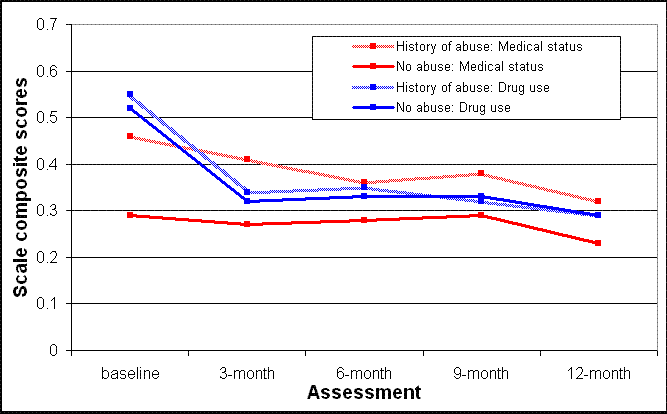Adverse childhood experiences, such as sexual or physical abuse, increase individuals’ risk for subsequent substance use (Felitti et al., 1998). The trauma of experiencing sexual or physical abuse might make it especially difficult to recover from substance abuse. In this week’s STASH, we review a recent study (Oviedo-Joekes et al., 2011) that, using a sample of opioid-dependent individuals, achieved two goals: (1) to examine how substance abuse treatment seekers with an abuse history differ from those without an abuse history; and (2) to evaluate the relationship between abuse history and treatment outcomes following 12 months of substance abuse treatment.
Methods
- This study analyzed data from a randomized clinical trial (RCT) that compared the effectiveness of different opioid-maintenance medications. A previous STASH provides more details about the study design.
- The RCT participants were 251 treatment-refractory, chronic opioid-dependent individuals.
- At baseline and at follow-up (i.e., 3, 6, 9 and 12 months), researchers assessed:
- Abuse history (i.e., past 30 day and lifetime emotional, physical, or sexual abuse)
- Drug use
- Previous alcohol and drug treatments
- Current status along a number of dimensions (e.g., medical status, psychiatric status), using European version of the Addiction Severity Index (i.e. EuropASI)1
- Socio-demographic characteristics (e.g., gender, age, and ethnicity)
- To achieve the first aim, the researchers compared, at treatment initiation, individuals who had a lifetime history of abuse (physical or sexual) with those who did not have a history of abuse.
- To achieve the second aim, the researchers compared follow-up scores within and between participants, adjusting for treatment condition and baseline values.
Results
- 44.5% of participants (n = 112) reported a history of abuse.
- At treatment initiation, participants with a history of abuse were more likely to be women, have a chronic medical problem, and have attempted suicide; they reported engaging in more previous drug and alcohol treatments; and they reported more severe legal, medical, and family relations problems.
- The mean difference scores from baseline to 12-month follow-up after controlling for treatment condition and gender showed similar levels of improvement in both groups on all scales, with the exception of medical status (see Figure 1).
- Participants with a history of abuse improved in terms of drug use (mean difference = -0.22) to an extent similar to participants without a history of abuse (mean difference = -0.20).
- Participants with a history of abuse improved more in terms of medical status (mean difference = -0.09) than participants without a history of abuse (mean difference = -0.03), p = 0.02

Figure. Scale composite scores from baseline through 12 months grouped by history of abuse and domain measured (medical status or drug use). Adapted from Oviedo-Joekes et al. (2011). Click image to enlarge.
Limitations
- This study is limited by the design of the parent study: the sample was a homogenous group of individuals with treatment-resistant chronic opioid dependence. It is unclear if the results would generalize to the population of opioid users.
- The items measuring abuse lacked specificity in terms of the nature, timing, and severity of abuse. It is possible that those who experienced particularly severe abuse or other forms of childhood maltreatment differed in meaningful ways from those who did not have such experiences. More refined abuse information might identify subgroups with different study outcomes.
- The treatment package included several aspects of care beyond maintenance medication (e.g., lifestyle counseling, referral to primary care, parenting skills development). These psychosocial interventions might have had therapeutic value for several of the life domains measured. However, the authors provide no information on the potential therapeutic value of individual treatment components.
Conclusion
This study supports the conclusion that traumatic experiences are associated with subsequent substance abuse. When they first presented for treatment, those who reported sexual or physical abuse had more severe problems across a number of life domains. However, these individuals showed a degree of improvement similar to those who did not report abuse and showed even greater medical status improvement. The supplemental psychosocial components might have played an important role in participants’ improvement. If future research supports this conclusion, program developers should include these component interventions within treatment programs designed for highly vulnerable individuals.
-Heather Gray
What do you think? Please use the comment link below to provide feedback on this article.
References
Felitti, V. J., Anda, R. F., Nordenberg, D., Williamson, D. F., Spitz, A. M., Edwards, V., et al. (1998). Relationship of childhood abuse and household dysfunction to many of the leading causes of death in adults. The Adverse Childhood Experiences (ACE) Study. American Journal of Preventative Medicine, 14(4), 245-258.
Oviedo-Joekes, E., Marchand, K., Guh, D., Marsh, D. C., Brissette, S., Krausz, M., et al. (2011). History of reported sexual or physical abuse among long-term heroin users and their response to substitution treatment. Addictive Behaviors, 36(1-2), 55-60.
________________
[1]The researchers did not analyze past-month abuse due to small numbers of positive responses. The researchers did not analyze emotional abuse due to a wide range of possible interpretations.




